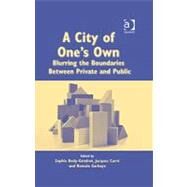A City of One's Own: Blurring the Boundaries Between Private and Public
, by Body-Gendrot,Sophie- ISBN: 9780754675020 | 0754675025
- Cover: Hardcover
- Copyright: 12/28/2008
This book sets out to illustrate the often overlooked fact that the initiatives of private individuals and bodies have always been a major feature of urban governance in English and American cities, before, during and after the heyday of 20th-century Welfare States. The title, 'A City of One's Own: Blurring the boundaries between private and public in historical and contemporary perspective' emphasizes the citizens' continuous participation in a wide range of urban affairs, especially outside institutional frameworks. The introduction explains the unity of purpose between the twelve chapters written by French, British and American social scientists, geographers and historians. The contributors point to a long and rich history of participation or partnership in British and American urban life (with occasional reference to France) showing that both private interests and community groups have long been involved in local policies. It is of course the concept of governance, derived from modern American studies of local politics, that provides the theoretical framework of the book. The imprecision of the frontiers between the proper territories of private and public actors has long been a major dilemma of Western liberal governments and local authorities. Then as now they have always hesitated about the boundaries of state intervention, and even about the definition of the public interest. This blurring of boundaries is now increasingly emphasized by urban historians to revise the classic accounts of 18th and 19th-century cities, as several chapters suggest. And it is clearly perceptible in the treatment of major urban issues of today. The book is arranged thematically, starting from the physical fabric of the city (planning and housing), leading on to major social questions (health, education, security) and closing on old and new forms of citizen participation. A concluding chapter assesses the amount of revision of urban history that seems possible on these lines, and examines the redefinition of the public interest that emerges from the contemporary case studies presented here.






